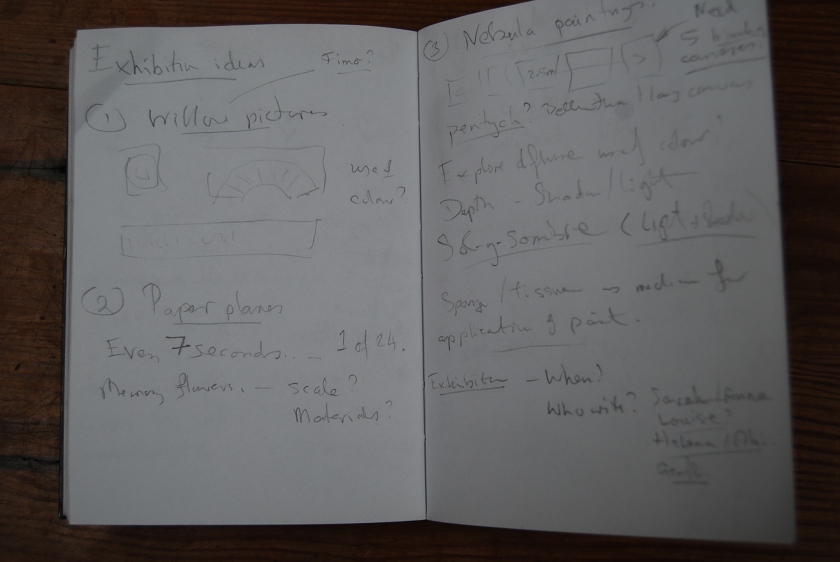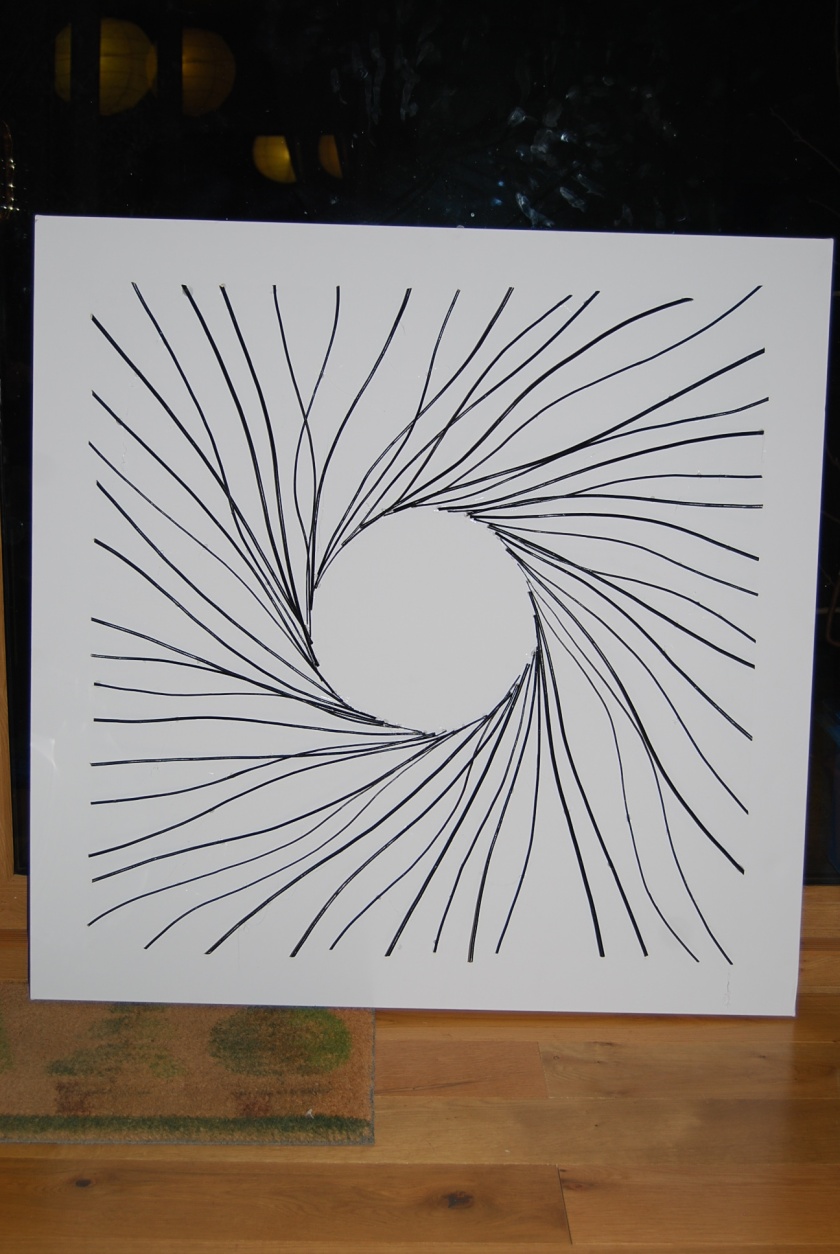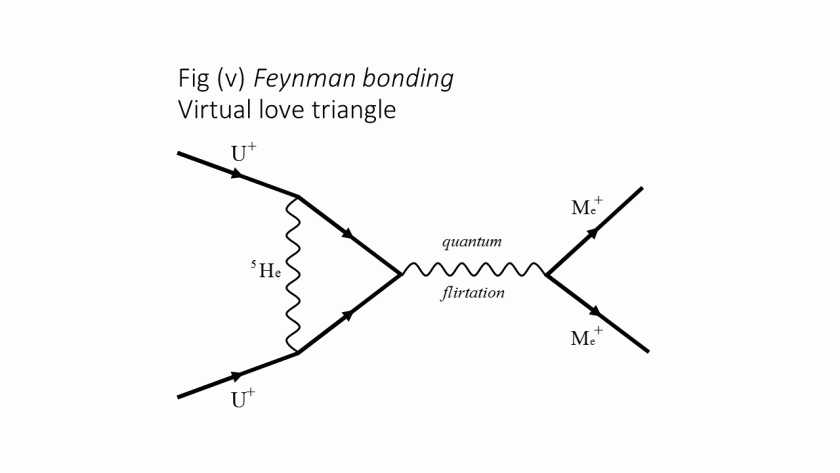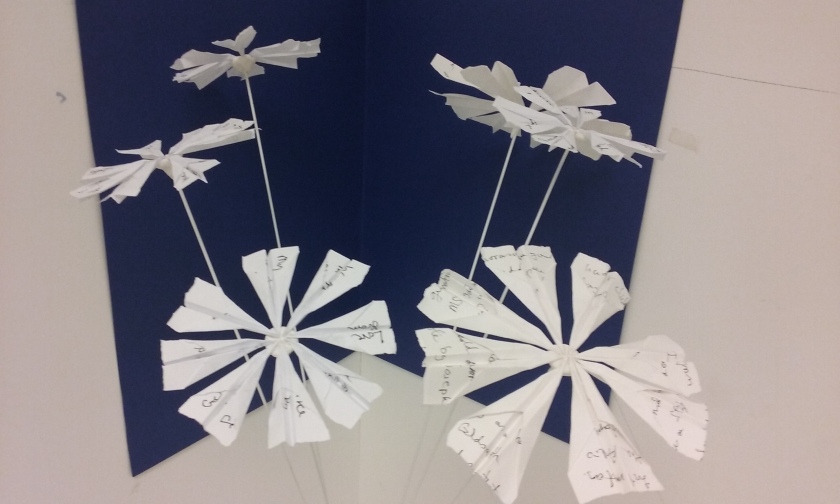WRAPPED DOLLS – 21/3/16
The wire wrapped dolls represent something in me. Suffering, Anger, Pain, Frustration. I was stricken with Multiple Sclerosis. MS is a random affliction. It strikes innocent victims by chance. As far as we know, there is nothing we have done to make our affliction more likely. This, perhaps, is why I have chosen baby/dolls as innocent victims of my torture. The wire is a symbol of nervous systems. Messages gone astray, diverted, destroyed by the progress of my condition.
MS manifests its’ presence in your body in many ways. Crushing fatigue, ghostly pain – needles, burning sensations, pressing/constricting/suffocating sensations. Cognitive difficulties. Fogging and clouding one’s faculties. Balance issues, falling, vertigo, depression, even suicidal thoughts.


These are photos of my first doll, wrapped in Earth shielding (insulation) not wire and pierced with pins. The tiny fingers stabbed with pins are meant to shock/revulse the viewer.
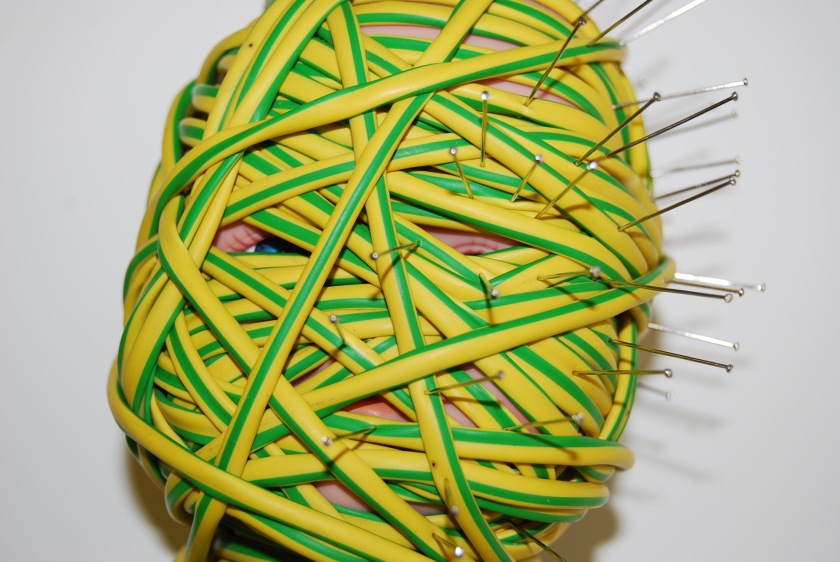
I like the glimpse of blue eye in the picture above. Human. A reminder of ‘real’babies.
Pins in and around the eyes. Optic neuritis (inflammation of the optic nerve, often resulting in temporary/partial blindness, is a common MS symptom.
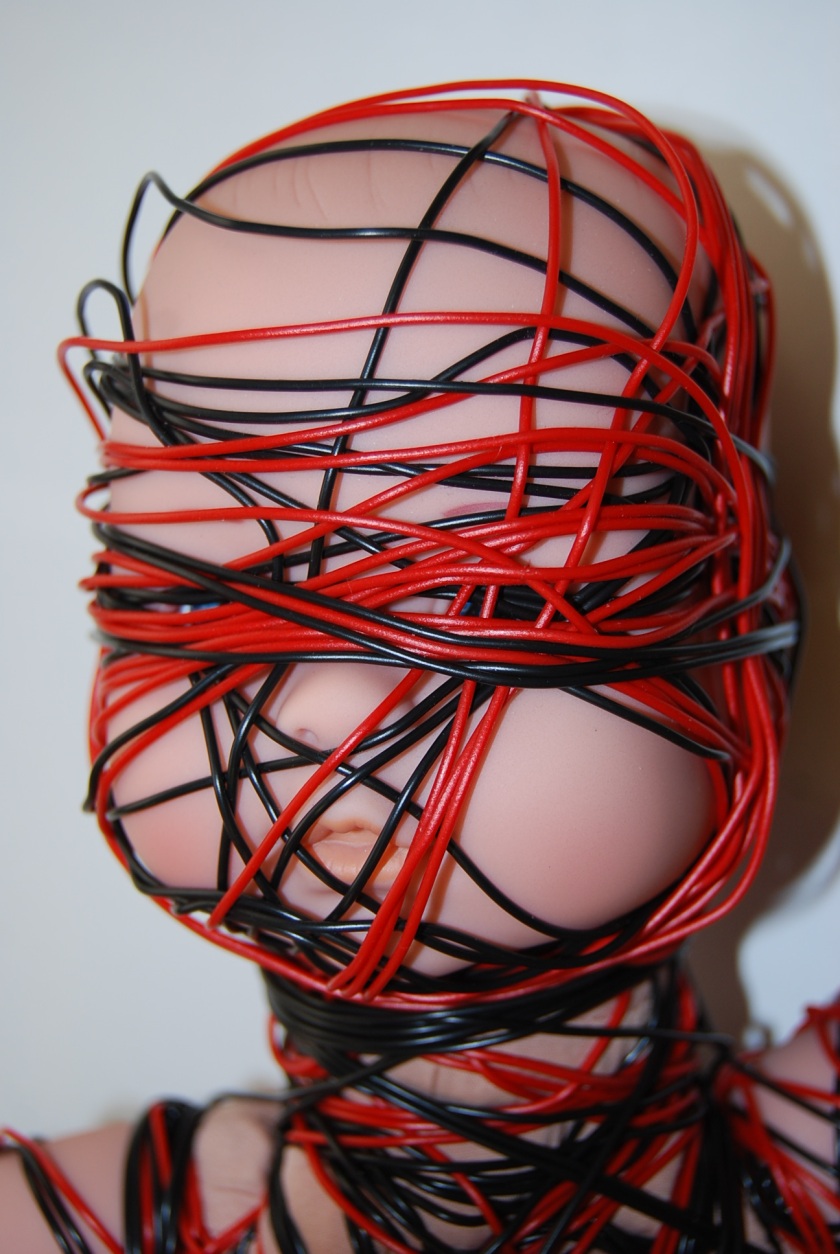
A second doll. This time wrapped in red and black wire. Chaotic. Tangled. The nose, lips and fingers still clearly visible. A blue eye again peeps at us despite the almost complete ‘blind-folding’ by the wrapping of the wire.

Red and black is strangely sexual. Reminiscent of S+M practices.
This doll will be hung, suspended from the ceiling in a permanent act of falling.

ISLAND OF THE DOLLS ( Islas de las muñecas ) – Xochimilco, near Mexico City.

Work by Julian Santana Barrera (born 1921, died 2001).
‘A two-hour canal ride from Mexico City lies Isla de las Muñecas, or the Island of the Dolls. It is the best-known chinampa, or floating garden, in Xochimilco. It belonged to a man named Julián Santana Barrera, a native of the La Asunción neighborhood. Santana Barrera was a loner, who was rarely seen in most of Xochimilco. According to the legend, Barrera discovered a little girl drowned in mysterious circumstances in the canals. He also found a doll floating nearby and, assuming it belonged to the deceased girl, hung it from a tree as a sign of respect. After this, he began to hear whispers, footsteps, and anguished wails in the darkness even though his hut—hidden deep inside the woods of Xochimilco—was miles away from civilization. Driven by fear, he spent the next fifty years hanging more and more dolls, some missing body parts, all over the island in an attempt to appease what he believed to be the drowned girl’s spirit. After Barrera’s death in 2001—his body reportedly found in the exact spot where he found the girl’s body fifty years before—the area became a popular tourist attraction where visitors bring more dolls. The locals describe it as “charmed”—not haunted—even though travelers claim the dolls whisper to them. Professional photographer Cindy Vasko visited the nightmarish island earlier this year and described it as the ‘creepiest place she has ever visited’. The excursion began through maze-like canals, surrounded by lush greenery and beautiful singing birds, but soon her boat was slowed down by a swarm of lily pads and the canal fell ominously silent. She told MailOnline: ‘At the end of the journey, the trajinera turned along a bend in the waterway and I was struck by a surreal vision of hundreds, maybe thousands, of dolls hanging from trees on the tiny island.’ Santana Barrera died in 2001. The dolls are still on the island, accessible by boat.’
https://en.wikipedia.org/wiki/Xochimilco#The_Island_of_the_Dolls
OTHER IMAGES
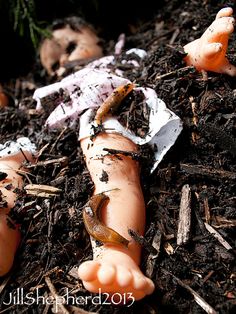
[ Photograph form ‘The Gardener’ (2013) Available from : jillshepherdphotography.com }
These pictures are influences but not progenitors of MS dolls project. They are again the result of a google search of ‘hanging dolls’ which opened out into a number of interesting photographs of dolls.
These are evocative and powerful images. The doll as a symbol of childhood, innocence and, somehow, they ‘are’ children/babies. It is shocking to see them cast aside, disfigured or abused.
This is an important element of my work/this project. MS, my condition, is largely invisible and it is easy to be complacent and overlook the suffering and pain of its’ victims.
The facts that we know so little of the origins or causes of MS and that it is visited upon people so randomly, without reason/blame is perplexing. More than this it makes me Angry! ANGER is an important emotion in this work.
I am a long way from accepting MS. There is an internal rage at what MS has taken away. I guess I have to express the hidden rage, the invisible pain (and other symptoms) in my Art. I want the viewer/s to question, ask themselves, how can I have missed this suffering? How can I have overlooked, have not seen, the pain that is borne by someone with MS?
I guess we are to blame. Too often people ask ‘How are you?’ and the answer is ‘OK, up and down’ or some such platitude. Truth is we suffer, we have lost and we keep quiet. Our silence is complicity. This project is about yelling and shouting and punching the face of an invisible aggressor!
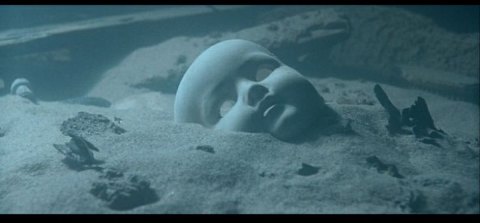
China dolls head on the seafloor, in sand, near the wreck of the Titanic. Taken as a still from the film of the wreck at the bottom of the North Atlantic.

Burned doll, Alicia, found at the remains of a house fire in New York on Christmas Eve in 1997 . The doll was put out on the curb and abandoned but was rescued by a neighbour.
Available from: http://www.ebay.com/itm/Haunted-Spirited-Paranormal-Scary-Burned-Doll-Spirit-Alicia-Creepy
NOTES ON DESIGN AND IMAGES OF INDIVIDUAL WORKS FROM MS DOLLS PROJECT
WATER

This is the image I chose to print to accompany the ‘Water’ sculpture in the exhibition. Close up of a doll submerged in cloudy water inside a large glass container. Hints of bubbles makes it all the more disturbing and baby-like.

This shows the clouded water well and the different colours of wire used to wrap the doll. I wanted to use changing colours to emphasize increasing depth of submersion. Neutral, buoyant, floating nature of doll’s pose is what I had aimed for.
Large glass vase (diameter c.30cm and height c.50cm) filled with water – coloured blue/clouded ? Like the idea of misting (clouding ) of the water to partially obscure doll/contents of water-filled vase.
The doll is fully submerged, perhaps closer to the surface – hope?
It is wrapped in mostly white wire with some blue/green.
Wires tie doll to rocks weighing it down.
Large stones (rounded pebbles), gravel (‘lightning stones’ collected in Lake Garda, Italy and sand (as a protective layer for glass) at bottom.
FIRE

Colour-balance enhanced and selective focus to create halo/crown of thorns effect. Originally, I selected this image to accompany/enhance installation of ‘Fire’ sculpture in Framework Gallery atrium but rejected it in favour of another image for final print.
These pictures were taken in Ashridge forest with a ‘bonfire’ of branches and leaves constructed on site.
The close up image below was the final choice used to accompany the installation for the exhibition at U of H.

The doll is wired to a central stake and a ‘bonfire’ of burnt (?) branches encloses the space around the burnt, blackened doll. The doll itself is wrapped in black wire.
This is reminiscent of witch burning.
I have an idea to burn the doll and film the event. I would fill, or partially fill, the wooden cone and set it alight. It will, hopefully, burn briefly and add burnt effects to the doll and soot, etc to the branches.
The video could be shown on screens at the top of the Lindop stairs.
[Location: Ivinghoe Beacon? Tring Park? At night/after dark.]
EARTH
The doll is wrapped in green and yellow EARTH shielding and partly buried in soil. It may be presented in a wooden tray and surrounded with a chicken wire ‘cage’ which will help to contain the leaves.

The pins are a reference to the sensations of ‘pins and needles’ felt by many with MS.
To expand upon wire-wrapping. Yes, it is representing the nervous system as a conducting network. It is externallising, making explicit the network within. Additionally, the wrapping, binding of the dolls speaks of the restrictions of MS. Our nerves and their decay hold us prisoner.
I have experimented with wire wrapping of canvasses (below). From pictures of the network of neurons in the brain I got some inspiration for rectilinear, almost textile/woven canvasses.
And why dolls? Well, they are innocent, child-like and blameless. Symbols of childhood. At the same time we ‘feel’ their mistreatment. I joke that ‘I torture my babies, but in a sense I’m serious. I take out my anger on something inanimate but imbued with a strange, synthetic humanity. These dolls ‘stand in’ for me. I am tortured by this condition. Blameless, innocent, I am plagued by this disease.
CRUSHED/FATIGUE.

This doll, wrapped in blue wire, is trapped between aerated concrete blocks separated by gap such that the doll is squeezed, obviously under pressure ( < 10cm). The gap is maintained bt steel bolts, screwed into the concrete and bolted to secure separation. I had initially planned to use metal cylinders but the blue steel here compiments the tones of the concrete blocks and the blue wire very nicely.
AIR


Pictures taken of doll suspended from tree in Ashridge forest. The doll was wrapped in red and black wire.
THIS SAINT AND MARTYR ( THIS IS TRUTH ).
I began with a title ‘MSaint MSebastian’ for this work but abandoned it is favour of ‘this saint …’ when I realised that I there was a message hidden within the words. THIS SAIN’T AND MARTYR ( THIS IS TRUTH ).
1  2
2 
[ 1. SCHONGAUER, M. (1469/74) Engraving printed on paper (154mm x 111mm) Clarence Buckingham Collection, Art Institute of Chicago.]
[ 2. RUBENS, P. P. ( c1614) 0il on canvas (200cm x 128cm) Gemaldgalerie auf der Kulturforum, Berlin.
This was originally painted for the Borghese family in Rome. Rubens was influeced by the work of Michelangelo which he saw in the Vatican collection. The pose is reminiscent of the Laocoon group (200BC – 70AD?) ]
St Sebastian was a martyr of early christianity. Martyred for proselitising, converting people to christianity. He was pierced by many arrows but recovered, hence his canonisation, but was later clubbed to death. He is a St associated with the bubonic plague. Patron saint of sufferers of the plague and said to offer protection from it.

My sculpture features a doll bound hands and feet to a tree stump, blindfolded with wire and with a modest loincloth also of black wire. The pose is as close to that in the paintings as I could get. In place of arrows I used syringes. The piece was mounted on MDF and placed on a plinth c1.2m tall to make it readily visible. Needles sleeves were arranged and glued around the doll.
This piece provoked the most comment. Placed, as it was, opposite the exit to one of the main teaching rooms. Many students commented and some were quite disturbed by it. It was meant to disturb ( Art should disturb!) and antipathy was expected.
3 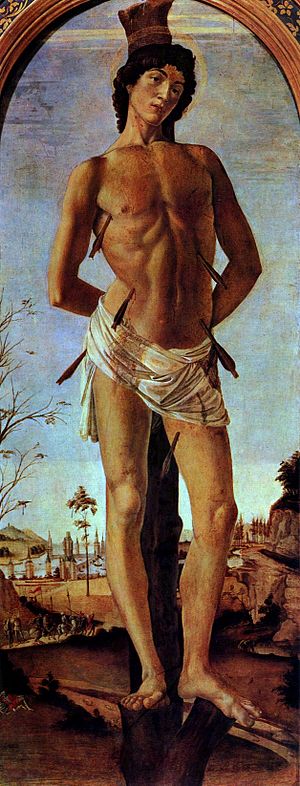 4
4 
[ 3. BOTTICELLI, S. (1474) St Sebastian. Tempera on wooden panel (195cm x 75cm) Staatliche Museen, Berlin. ]
[ 4. MANTEGNA, A. (1490) The martyrdom of St Sebastian, also known as St Sebastian of Venice. Tempera on wooden panel (210cm x 91cm) Ca’d’Oro, Venice. ]
Note the pose of the doll here. Blidfolded and bound to a stake, reminiscent of execution (by firing squad) of prisoners. Why are all of my dolls blidfolded? Perhaps it is a comment, unconscious, on the uncertainty of MS. I cannot see the future, none of us can, but maybe I don’t want to see the future. These sculptures are a commentary on the symptoms and effects of MS now. The future progress of the disease is unwritten and not a little scary!
PHOTOGRAPHS OF EXHIBITION
Corridor with illustrative photograph for ‘Earth’, picture for ‘Fire’ just visible between Anna’s gowns and her fabric printed micrographs. The photo of ‘Water’ in situ in UofH with illustrating picture above. Sand, pebbles and rocks visible at the bottom of the vase – doll attached by white wire to two large rocks at the bottom.
Picture used to illustrate ‘Crushed/Fatigue’ shows clips and nails used to hang pictures. The ‘Air/Falling’ dolls was suspended by wires at 90° to the wall.
Three sculptures – ‘Fire’ (foreground) and ‘Crushed/Fatigue’ (top right) with ‘Saint and Martyr’ (top left) in situ in Framework Gallery Atrium. The other work in the atrium was ‘Earth’ which appears to have emerged from the ground beneath the paving in the atrium.

I placed ‘Crushed/Fatigue’ on four aerated concrete blocks to increase height and visibility.
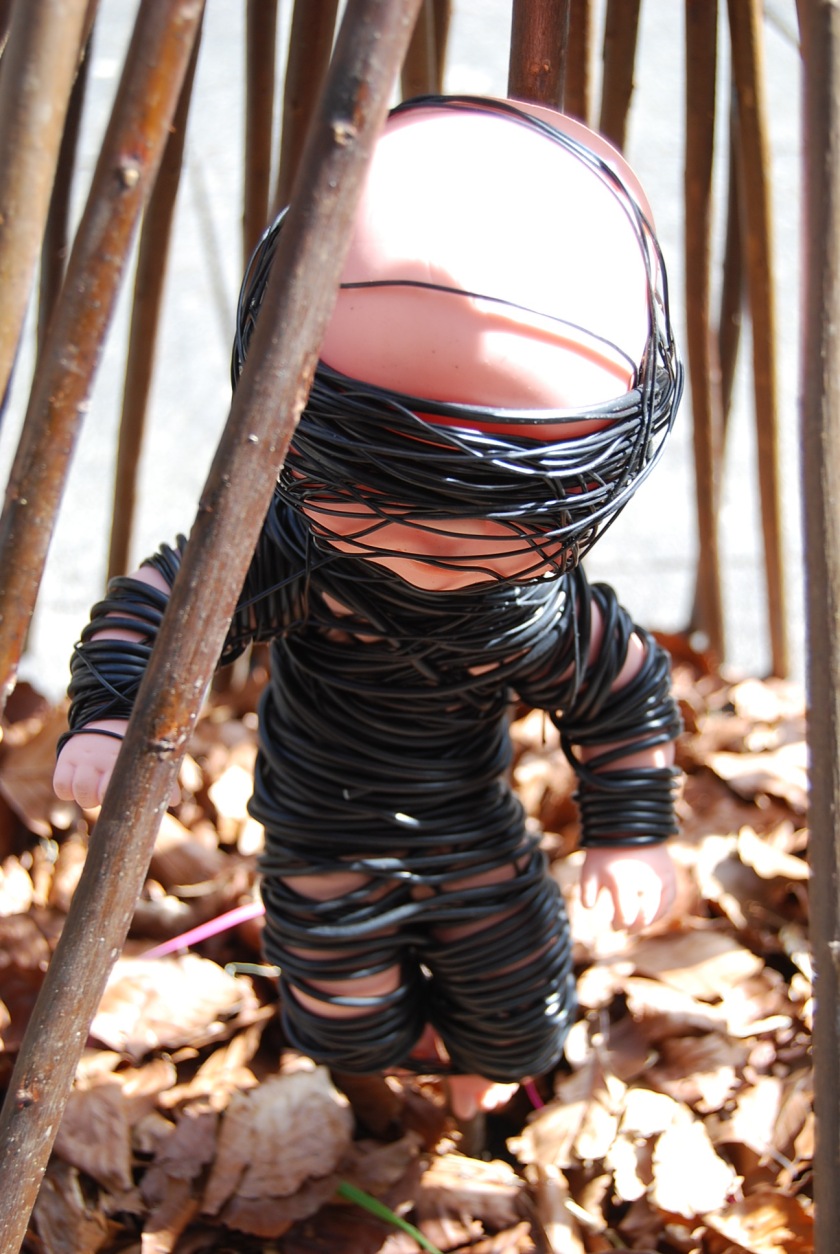
‘Fire’ is shown in a bonfire of willow twigs and leaves. Leaves blew all over the atrium giving a hint of autumn to the installation. Before the private view on 10/5/16 extra budles of black willow twigs were added to prevent leaves from blowing away from the piece.


























